Moving into a comfortable adulthood, the annual Guelph Jazz Festival (GJF), September 3 to 7, hasn’t abandoned its presentation of new artists. However it has reached the state where musicians who have been there in the past are returning, but mostly in new contexts. Case in point in 2014, the 100th anniversary of bandleader Sun Ra’s arrival on this planet – he returned to the cosmos in 1993 – where the Sun Ra Arkestra, now under the direction of alto saxophonist Marshall Allen, gives two performances on September 6. The first is an afternoon parade; the second couples the band with dancers from the Colman Lemieux Company for “Hymn to the Universe,” a multi-media presentation at the River Run Centre (RRC).
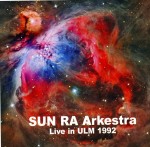 Minus the visuals you can sample a Sun Ra Arkestra performance on Live in Ulm 1992 (Golden Years of Jazz GY 30/31 leorecords.com) when Ra, the man from Saturn, was still in charge. Unusual because there’s extended input from trombonist Tyrone Hill, guitarist Bruce Edwards and electric bassist Jothan Collins, this 10-piece Arkestra features four drummers, two reedists and two trumpeters who faultlessly follow the segues directed by Ra’s piano. An intense track like The Shadow World is defined by screaming reed multiphonics as the rest of the orchestra harmonizes; while James Jacson’s nasal oboe and Allen’s guttural flute bring otherworldly exotica to The Mayan Temples just as a bass vamp and percussion bumps keep it attached to terra firma. Elsewhere the percussionists’ claves produce a montuno pulse on a Latinized version of Fate in a Pleasant Mood, but before the dance beat becomes too predictable, Ra slips in references to other Ra classics while sounding if he’s playing a honky-tonk keyboard. Suggestions of spirituals and the Second Line alternate with brassy crescendos, and just as you think all the tricks have been revealed, the group presents a raucous recreation of Fletcher Henderson’s Hocus Pocus. Later there’s a vocal version of Prelude to a Kiss whose clip-clop backing is crowned by a strident Allen solo. With marching band precision and rhythmic hand claps, most of the second CD is given over to a singalong medley of Ra’s greatest hits including Space is the Place, We Travel the Spaceways and Outer Spaceways Incorporated. Ra may have left this earth, but the Arkestra continues impressing people.
Minus the visuals you can sample a Sun Ra Arkestra performance on Live in Ulm 1992 (Golden Years of Jazz GY 30/31 leorecords.com) when Ra, the man from Saturn, was still in charge. Unusual because there’s extended input from trombonist Tyrone Hill, guitarist Bruce Edwards and electric bassist Jothan Collins, this 10-piece Arkestra features four drummers, two reedists and two trumpeters who faultlessly follow the segues directed by Ra’s piano. An intense track like The Shadow World is defined by screaming reed multiphonics as the rest of the orchestra harmonizes; while James Jacson’s nasal oboe and Allen’s guttural flute bring otherworldly exotica to The Mayan Temples just as a bass vamp and percussion bumps keep it attached to terra firma. Elsewhere the percussionists’ claves produce a montuno pulse on a Latinized version of Fate in a Pleasant Mood, but before the dance beat becomes too predictable, Ra slips in references to other Ra classics while sounding if he’s playing a honky-tonk keyboard. Suggestions of spirituals and the Second Line alternate with brassy crescendos, and just as you think all the tricks have been revealed, the group presents a raucous recreation of Fletcher Henderson’s Hocus Pocus. Later there’s a vocal version of Prelude to a Kiss whose clip-clop backing is crowned by a strident Allen solo. With marching band precision and rhythmic hand claps, most of the second CD is given over to a singalong medley of Ra’s greatest hits including Space is the Place, We Travel the Spaceways and Outer Spaceways Incorporated. Ra may have left this earth, but the Arkestra continues impressing people.
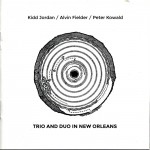 Another veteran musician who has helped extend the lineage of jazz is New Orleans-based tenor saxophonist Kidd Jordan. He returns to the GJF September 6 to play the River Run Centre’s Co-operators Hall with another Free Jazz pioneer, drummer Milford Graves, plus Canadian pianist D. D. Jackson. Jordan and Graves haven’t recorded together but Trio and Duo in New Orleans (NoBusiness Records NBCD 64/65 nobusinessrecords.com) suggests how they may sound since here the saxophonist’s partner is another Free Jazz percussion pioneer: Alvin Fielder. More interesting is the second CD of duos, although both are also in top form on the first CD that adds the late bassist Peter Kowald. Jordan’s tempered split tones and stentorian output that stands up to every challenge are completely original. In the main, he’s comfortable in the altissimo register and on pieces such as Duo Flight, invention is paired with stridency as screeched multiphonics alternate with moderato slurs. Fielder uses shakes and shudders from percussion add-ons to make his points. In the final minutes, as Jordan moves into lower pitches, the two attain a spiky rapprochement that brings in bop echoes. Even when Fielder takes a protracted solo as he does on E. Fashole-Luke, there’s no show-off commotion, just moderated pizzazz. The drummer’s ruffs, ratamacues and rebounds show a man in perfect command of his kit. This sound authority extends to Jordan, who utilizes screams and melisma to build up to major saxophone statements. That the CD’s final track was recorded seven years after the first four, with no letdown in power, is a confirmation of the musicians’ skills.
Another veteran musician who has helped extend the lineage of jazz is New Orleans-based tenor saxophonist Kidd Jordan. He returns to the GJF September 6 to play the River Run Centre’s Co-operators Hall with another Free Jazz pioneer, drummer Milford Graves, plus Canadian pianist D. D. Jackson. Jordan and Graves haven’t recorded together but Trio and Duo in New Orleans (NoBusiness Records NBCD 64/65 nobusinessrecords.com) suggests how they may sound since here the saxophonist’s partner is another Free Jazz percussion pioneer: Alvin Fielder. More interesting is the second CD of duos, although both are also in top form on the first CD that adds the late bassist Peter Kowald. Jordan’s tempered split tones and stentorian output that stands up to every challenge are completely original. In the main, he’s comfortable in the altissimo register and on pieces such as Duo Flight, invention is paired with stridency as screeched multiphonics alternate with moderato slurs. Fielder uses shakes and shudders from percussion add-ons to make his points. In the final minutes, as Jordan moves into lower pitches, the two attain a spiky rapprochement that brings in bop echoes. Even when Fielder takes a protracted solo as he does on E. Fashole-Luke, there’s no show-off commotion, just moderated pizzazz. The drummer’s ruffs, ratamacues and rebounds show a man in perfect command of his kit. This sound authority extends to Jordan, who utilizes screams and melisma to build up to major saxophone statements. That the CD’s final track was recorded seven years after the first four, with no letdown in power, is a confirmation of the musicians’ skills.
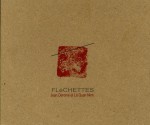 Another sax-drum duo of equal quality unrolls on September 5 at the Guelph Youth Music Centre (GYMC) with American multi-instrumentalist Joe McPhee and French percussionist Lê Quan Ninh. Highly praised for his mastery of contemporary notated music, Ninh is equally proficient as an improviser as he demonstrates with Montreal saxophonist Jean Derome on Fléchettes (Tour de Brass TDB 9004cd tourdebrass.com). During the course of one over-40-minute track the two face off like friendly gladiators lobbing back and forth any texture suggested by one or the other. Using only a giant, horizontal bass drum Ninh’s creations take on spatial as well as sonic qualities. Scraping, sliding and stroking a variety of timbres from his drum, he uses room architecture to amplify and expand rim shots plus wood abrasions, while creating electronic-like drones. Making use of all registers of his alto saxophone and flute, Derome’s interface is as dissonant as it is startling. His emotional expressions are sourced from flatulent guzzling slide-whistle-like peeps and piercing duck calls. In the duet’s final minutes a rapprochement established with the broken-octave improvisations finally fades following ghostly cries from Derome’s horn and answering rubs from Ninh’s drum top.
Another sax-drum duo of equal quality unrolls on September 5 at the Guelph Youth Music Centre (GYMC) with American multi-instrumentalist Joe McPhee and French percussionist Lê Quan Ninh. Highly praised for his mastery of contemporary notated music, Ninh is equally proficient as an improviser as he demonstrates with Montreal saxophonist Jean Derome on Fléchettes (Tour de Brass TDB 9004cd tourdebrass.com). During the course of one over-40-minute track the two face off like friendly gladiators lobbing back and forth any texture suggested by one or the other. Using only a giant, horizontal bass drum Ninh’s creations take on spatial as well as sonic qualities. Scraping, sliding and stroking a variety of timbres from his drum, he uses room architecture to amplify and expand rim shots plus wood abrasions, while creating electronic-like drones. Making use of all registers of his alto saxophone and flute, Derome’s interface is as dissonant as it is startling. His emotional expressions are sourced from flatulent guzzling slide-whistle-like peeps and piercing duck calls. In the duet’s final minutes a rapprochement established with the broken-octave improvisations finally fades following ghostly cries from Derome’s horn and answering rubs from Ninh’s drum top.
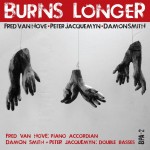 Drummer Lou Grassi partners another improv master, Belgian pianist Fred Van Hove on a GYMC double bill on September 6. Like Jordan, whose commitment to free expression goes back to the 1960s, the pianist works in many contexts. One unusual set-up is captured on Burns Longer (Balance Point Acoustics BPA2 balancepointacoustics.com) playing with Belgian bassist Peter Jacquemyn and American bassist Damon Smith. Grinding and goosing their eight strings the two scramble to keep up with Van Hove whose cadenza stream almost sweeps any interference out of his way. Not that this is a one man show. Both bull fiddlers hold their own, with one fortifying the rhythmic pulse and the other stropping strings. Sharpened stops squeak from the highest register as often as bowed textures outline more supple textures. Although Archiduc 2 is the most pianistic of the tracks, as Van Hove dampens his note waterfall by percussively stopping inner strings, the concluding 35-minute Archiduc 3 defines the narratives. Unexpectedly uncrating his accordion so that tremolo glissandi create an ostinato underpinning, the bassists’ response is close to what could be heard on a baroque recital. Back on piano, Van Hove’s kineticism increases. Yet the technical expertise of Smith and Jacquemyn allows them to not only respond with buoyant tones but also to mutate these timbres to resemble harsh blowing from saxophones or didgeridoos. Finally just as it seems as if the mixture of splayed strings and cascading lines can’t get any more exciting, the trio reaches a crescendo of interactive polyphony as the altered chords and tremolo strokes meld.
Drummer Lou Grassi partners another improv master, Belgian pianist Fred Van Hove on a GYMC double bill on September 6. Like Jordan, whose commitment to free expression goes back to the 1960s, the pianist works in many contexts. One unusual set-up is captured on Burns Longer (Balance Point Acoustics BPA2 balancepointacoustics.com) playing with Belgian bassist Peter Jacquemyn and American bassist Damon Smith. Grinding and goosing their eight strings the two scramble to keep up with Van Hove whose cadenza stream almost sweeps any interference out of his way. Not that this is a one man show. Both bull fiddlers hold their own, with one fortifying the rhythmic pulse and the other stropping strings. Sharpened stops squeak from the highest register as often as bowed textures outline more supple textures. Although Archiduc 2 is the most pianistic of the tracks, as Van Hove dampens his note waterfall by percussively stopping inner strings, the concluding 35-minute Archiduc 3 defines the narratives. Unexpectedly uncrating his accordion so that tremolo glissandi create an ostinato underpinning, the bassists’ response is close to what could be heard on a baroque recital. Back on piano, Van Hove’s kineticism increases. Yet the technical expertise of Smith and Jacquemyn allows them to not only respond with buoyant tones but also to mutate these timbres to resemble harsh blowing from saxophones or didgeridoos. Finally just as it seems as if the mixture of splayed strings and cascading lines can’t get any more exciting, the trio reaches a crescendo of interactive polyphony as the altered chords and tremolo strokes meld.
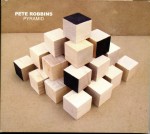 Another pianist returning to Guelph on a Co-operators Hall double bill on September 4 is Vijay Iyer whose trio includes drummer Tyshawn Sorey. Both are on featured on Pyramid, where alto saxophonist Pete Robbins mixes his fine-boned originals with jazz variations on tunes by Guns’n’Roses, Stevie Wonder, Nirvana and even Jimmy Webb (Hate Laugh Music 003 peterobbins.com). Playing with a Paul Desmond-like fluidity but a harder tone, Robbins’ recreations are neither smooth nor funk jazz. Instead the improvisations toughen a tune like Wichita Lineman, as Iyer’s molten swing runs contrast to Robbins’ relaxed reading of the head; or add unprecedented free-form motions to rock anthems. Lithium is given a Latin treatment as the pianist’s fleet fingering deconstructs the bridge, only to speed up returning to the familiar theme. Meanwhile the altioist’s reed vibrations and the pianist’s chording unearth the near-symphonic underpinning of Hallelujah. The Robbins-composed title tune showcases Sorey’s powerful backbeat; while a strummed solo from bassist Eivind Opsvik defines the groove on Too High. The probability of Iyer and Sorey presenting any Nirvana or Wonder songs during their concert is pretty slim. But considering the GJF’s reputation for showcasing unconventional music, and the breadth of the performers’ talents this year, who know what may take place?
Another pianist returning to Guelph on a Co-operators Hall double bill on September 4 is Vijay Iyer whose trio includes drummer Tyshawn Sorey. Both are on featured on Pyramid, where alto saxophonist Pete Robbins mixes his fine-boned originals with jazz variations on tunes by Guns’n’Roses, Stevie Wonder, Nirvana and even Jimmy Webb (Hate Laugh Music 003 peterobbins.com). Playing with a Paul Desmond-like fluidity but a harder tone, Robbins’ recreations are neither smooth nor funk jazz. Instead the improvisations toughen a tune like Wichita Lineman, as Iyer’s molten swing runs contrast to Robbins’ relaxed reading of the head; or add unprecedented free-form motions to rock anthems. Lithium is given a Latin treatment as the pianist’s fleet fingering deconstructs the bridge, only to speed up returning to the familiar theme. Meanwhile the altioist’s reed vibrations and the pianist’s chording unearth the near-symphonic underpinning of Hallelujah. The Robbins-composed title tune showcases Sorey’s powerful backbeat; while a strummed solo from bassist Eivind Opsvik defines the groove on Too High. The probability of Iyer and Sorey presenting any Nirvana or Wonder songs during their concert is pretty slim. But considering the GJF’s reputation for showcasing unconventional music, and the breadth of the performers’ talents this year, who know what may take place?



